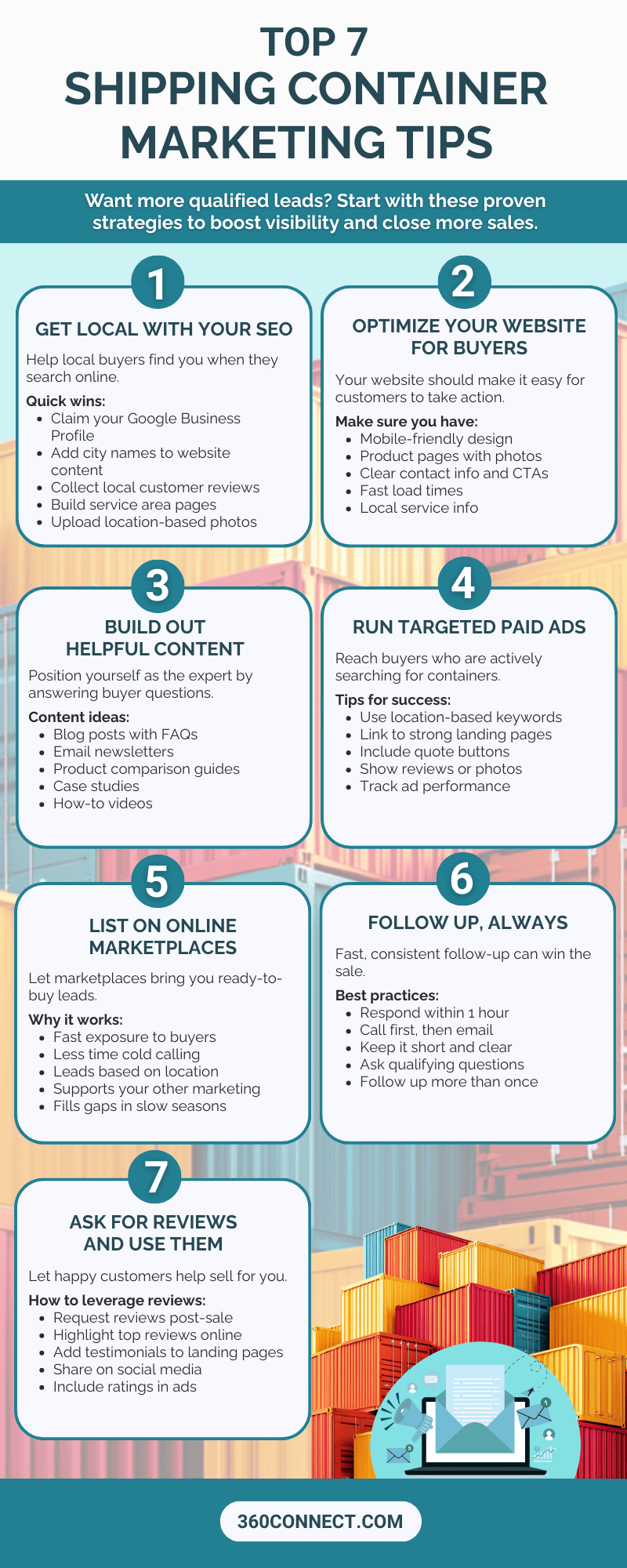Looking to sell more shipping containers? You’ve come to the right place. The term shipping container marketing doesn’t exactly roll off the tongue, and if you’ve ever searched for advice on how to promote your business, you’ve probably come up short. That’s exactly why we put together this guide. We know it can be tough to find marketing tips that actually apply to your industry, especially when you’re dealing with something as specific as shipping/storage containers.
In general, shipping container marketing isn’t just about getting your name out there. Sure, that’s part of it. But what it’s really about is getting in front of the right buyers at the right time, people who need your product and are ready to make a decision.
The demand for shipping containers is rising, thanks to increased activity in construction, retail storage, education, and even modular building projects. The global shipping container market was valued at $9.3 billion in 2021 and is projected to reach $16.75 billion by 2031, growing at a CAGR of 6.0% from 2022 to 2031. That’s a massive jump, one that signals growing opportunity, but also stiffer competition. If you’re not actively marketing your business, you’re likely missing out on sales.
In this blog, we’ll walk through what shipping container marketing actually means, why it matters, and the top strategies to help your business stand out, both locally and online.
Related: How to Get Portable Storage Container Leads
The Importance of a Solid Shipping Container Marketing Plan
So is a plan the same thing as a strategy? Not exactly. In this blog, we’re covering shipping container marketing strategies, but it’s just as important to have a plan in place. A marketing plan typically outlines your goals, target customers, messaging, and budget. Your strategies are the specific actions you take to execute that plan.
Why does that matter? Because without a plan, your marketing becomes a guessing game. A good shipping container marketing plan keeps you consistent, even during slow seasons. It gives direction to your SEO, ads, sales outreach, and content so everything works together toward the same goal.
Think of it as your foundation. The strategies we’ll go over next are most effective when they’re part of a clear, focused plan.
Inbound vs Outbound Shipping Container Marketing
Next, let’s go over the two main types of marketing: inbound and outbound. Both have a place in your shipping container marketing strategy, but they work a little differently.
Inbound shipping container marketing brings customers to you. This includes things like search engine optimization (SEO), blogs, email newsletters, and social media. You’re creating content or resources that answer buyer questions and get them to reach out to you when they’re ready. The benefit? Inbound leads are usually warmer, more informed, and already interested in what you offer.
On the other hand, outbound shipping container marketing is when you reach out directly to potential customers. Think cold calls, emails, mailers, and ads. This type of marketing can be effective for getting in front of buyers quickly, especially if you have a strong pitch or a time-sensitive offer. However, it can also require more effort and tends to be less targeted if you’re not careful.
The best approach? Use both. Combine inbound tactics that bring buyers in with outbound methods that help you stay proactive. That way, your shipping container marketing strategy stays balanced and works across the entire sales funnel.
Top Shipping Container Marketing Tips
Now let’s get into the part you’ve been waiting for: actionable tips. Here’s what works when it comes to effective shipping container marketing.

1. Get Local with Your SEO
A lot of shipping container buyers are looking for local solutions. If someone is in Dallas and types “shipping containers for sale near me,” your business should pop up. To make that happen, you need a strong local SEO game. Start by claiming your Google Business Profile, using keywords like “shipping containers in [your city],” and adding your address to your website.
This step alone can make a big difference in your shipping container marketing success. Local visibility helps you get found by real buyers, not just random traffic.
Easy ways to improve local SEO:
- Claim and update your Google Business Profile
- Add your city name to key website pages
- Encourage happy customers to leave local reviews
- Create service area pages if you serve multiple cities
- Add location-specific photos to your site and listings
2. Optimize Your Website for Buyers
If your website looks outdated, loads slowly, or doesn’t have clear contact information, it’s costing you sales. Your site should be simple, professional, and geared toward helping buyers find what they need fast. Include clear call-to-actions, product pages with photos, and pricing ranges if possible.
In the world of shipping container marketing, your website is often the first impression. Make it count.
Must-haves for your website:
- Product/service pages with photos and specs
- Mobile-friendly layout and fast load speed
- Easy-to-find contact form or phone number
- Clear CTAs like “Request a Quote”
- Service area or location information
3. Build Out Helpful Content
Want to build trust and improve your SEO at the same time? Create content that answers buyer questions. Think blog posts like “How Much Do Shipping Containers Cost?” or “Top Uses for Storage Containers in Construction.” These types of articles help you show up on search engines and position you as an expert in the space.
Plus, content is a long-term win. Once it’s up, it keeps working for your shipping container marketing strategy day and night.
Helpful content you should consider creating:
- Blog articles that answer FAQs
- Email newsletters with seasonal updates
- Comparison guides (rent vs. buy, new vs. used)
- Case studies or customer success stories
- How-to videos or explainer graphics
4. Run Targeted Paid Ads
Sometimes you need a faster way to drive leads. Paid ads can help you get in front of buyers who are actively searching. Google Ads are a good start, especially if you bid on high-intent phrases like “shipping containers for rent” or “buy storage containers in [location].” You can also try Facebook or LinkedIn ads, depending on your target market.
The key is to make sure your ads lead to a strong landing page that encourages people to take action. Without that, you’re just paying for clicks that don’t convert.
Tips for running better ads:
- Target location-based keywords
- Include your phone number or a quote button
- Use landing pages instead of your homepage
- Add customer testimonials or photos to ads
- Set a realistic daily budget and track results
5. List on Online Marketplaces
Online marketplaces are a great way to boost your shipping container marketing efforts. Sites that connect buyers and sellers help you get found by people already in buying mode. These platforms do a lot of the heavy lifting, like screening leads and routing them to you based on location and need.
Instead of waiting for people to find your website, marketplaces bring the traffic to you. It’s a solid way to grow, especially if you’re trying to expand your customer base quickly.
Benefits of listing on marketplaces:
- Immediate exposure to interested buyers
- Less time spent cold calling or prospecting
- Leads matched to your location or inventory
- Helps fill your pipeline during slow months
- Works alongside your own marketing efforts
6. Follow Up, Always
This one sounds simple, but a lot of suppliers miss it. When someone reaches out, follow up fast. Whether it’s by phone, email, or text, your response time matters. The longer you wait, the more likely that buyer is to go elsewhere.
Shipping container marketing doesn’t stop once the lead comes in. Your follow-up process is just as important as your ads or content.
Best practices for follow-up:
- Respond within 5 minutes (or at least within an hour)
- Call first, then follow up with an email
- Keep messages short and clear
- Ask clarifying questions to qualify the buyer
- Set a reminder for a second follow-up if no response
7. Ask for Reviews and Use Them
Buyers trust other buyers. If you have happy customers, ask them to leave a review on Google or Yelp. Then, showcase those reviews on your website and social media. It adds credibility and can help move new prospects closer to a decision.
In an industry like this, word of mouth still matters. Use reviews to your advantage as part of your shipping container marketing plan.
Where and how to use reviews:
- Ask for reviews from satisfied customers after delivery
- Display top reviews on your homepage
- Add testimonials to landing pages
- Share them on social media posts
- Include star ratings in paid ads
Final Thoughts on Shipping Container Marketing
Marketing doesn’t have to be overwhelming. When done right, shipping container marketing helps you get more visibility, close more deals, and keep your pipeline full year-round. The key is staying consistent and choosing strategies that make sense for your business, not just copying what everyone else is doing.
Whether you’re new to shipping container marketing or just trying to level up your efforts, there’s no better time to start than now. Small improvements, like updating your website or launching a few local ads, can have a big impact.
And remember, you don’t have to do it all alone.
Want Quality Storage Container Leads?
We connect suppliers like you with verified, true-intent leads daily. If you’re ready to grow your business, we can help.

